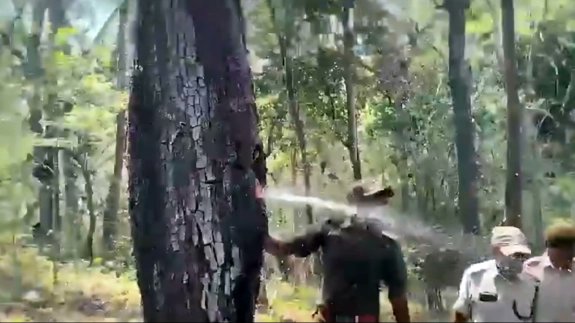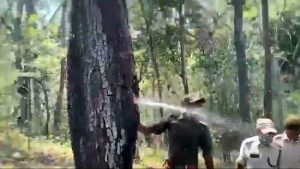
Konda Reddi tribe, members educated forest officials about the tree
The tree is called scientifically referred to as Ficus microcarpa
This comes amidst a period of water scarcity plaguing cities
Forest department authorities in Andhra Pradesh’s Alluri Sitharama Raju district have garnered attention after cutting the bark of an Indian laurel tree, revealing a surprising gush of water. The incident, captured in a viral video circulating on social media, has left viewers astonished.
Also Read: Bengaluru water crisis: Rain Water Harvesting could have mitigated the consequences
The tree, situated within the confines of Papikonda National Park, was subjected to the unique procedure by forest officials who sought to explore its water storage capabilities, particularly during the summer months.

Remarkably, the knowledge of the tree’s water-retaining properties was imparted to the forest department by the Konda Reddi tribe, a vulnerable indigenous group residing in the Papikonda hill range of the Godavari region. Renowned for their expertise in arboreal matters, the tribe shared invaluable insights into the local flora.
Scientifically referred to as Ficus microcarpa, the Indian laurel tree is native to various regions across Asia, Western Pacific Islands, and Australia. Its distinctive characteristics include a smooth, light-gray bark, shiny green lanceolate leaves, and small round figs that serve as a food source for birds.
The revelation of water gushing from the tree’s bark comes amidst a period of water scarcity plaguing several parts of India, including Andhra Pradesh and neighboring Karnataka, notably the capital city of Bengaluru. Reservoir levels in Andhra Pradesh currently stand at 22 percent, a significant departure from the 66 percent recorded last year. Similar water shortages are observed in other major states across the country, emphasizing the pressing need for sustainable water management practices.

Konda Reddi tribe, members educated forest officials about the tree
The tree is called scientifically referred to as Ficus microcarpa
This comes amidst a period of water scarcity plaguing cities
Forest department authorities in Andhra Pradesh’s Alluri Sitharama Raju district have garnered attention after cutting the bark of an Indian laurel tree, revealing a surprising gush of water. The incident, captured in a viral video circulating on social media, has left viewers astonished.
Also Read: Bengaluru water crisis: Rain Water Harvesting could have mitigated the consequences
The tree, situated within the confines of Papikonda National Park, was subjected to the unique procedure by forest officials who sought to explore its water storage capabilities, particularly during the summer months.

Remarkably, the knowledge of the tree’s water-retaining properties was imparted to the forest department by the Konda Reddi tribe, a vulnerable indigenous group residing in the Papikonda hill range of the Godavari region. Renowned for their expertise in arboreal matters, the tribe shared invaluable insights into the local flora.
Scientifically referred to as Ficus microcarpa, the Indian laurel tree is native to various regions across Asia, Western Pacific Islands, and Australia. Its distinctive characteristics include a smooth, light-gray bark, shiny green lanceolate leaves, and small round figs that serve as a food source for birds.
The revelation of water gushing from the tree’s bark comes amidst a period of water scarcity plaguing several parts of India, including Andhra Pradesh and neighboring Karnataka, notably the capital city of Bengaluru. Reservoir levels in Andhra Pradesh currently stand at 22 percent, a significant departure from the 66 percent recorded last year. Similar water shortages are observed in other major states across the country, emphasizing the pressing need for sustainable water management practices.
